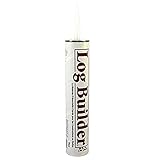Log home chinking solves the issue of sealing any gaps between the logs that allow air infiltration as a result of a log home’s construction. The thick log walls and sealed gaps then offer an energy-efficient thermal mass that rivals any type of construction.
Traditional chinking was often made of clay, sand, and lime, sometimes mixed with a filler. Now there is a high-tech, flexible caulk with excellent properties that act as the chinking between the logs and last longer and perform better than traditional methods. The use of foam backing or backer rods provides the expansion space necessary for long elastic life.
I use the terms “chinking” and “caulking” interchangeably here, but they both refer to the mortar-like material applied between courses of logs in a cabin. Cabins that are deliberately built with spaces between the logs to accommodate chinking are called “chinkers” or chink-style cabins.
Jump to:
Chinking Adhesion and Cohesion
Effective caulking or chinking requires two things:
- Good adhesion - meaning that the chinking or caulk sticks to the logs where it’s applied. It must adhere to the logs themselves and not simply fill the gap.
- Good cohesion - meaning that the chinking or caulk sticks together even under stress. It must be sufficiently elastic to handle the normal expansion and contraction that wood experiences.
Log walls are a dynamic structure that expands and contracts with heat, cold and varying moisture conditions. This internal movement means the chinking is stressed and it must be able to flex and not break or split apart.
Log home chinking provides a barrier to air and moisture infiltration, as well as keeping bugs out. It is also a log home design feature with your choice of chinking color blending or contrasting with the color of your logs.
Prepare For Proper Chinking
Proper chinking that will achieve its purpose and last a long time requires preparing for the most efficient caulk joint, and this has four elements:
- Depth of the chinking - chinking depth should be no more than ½”; any more than that and it won’t be able to stretch and compress adequately.
- Points of adhesion - only two points of adhesion is best, since with three points (top log, bottom log, and back of joint) the chinking may be torn apart in multiple directions with the movement of the logs.
- Easy to fit - soft and pliable so it fits into the joint easily
- Water resistant - unlike open cell backer rod, it repels water to help protect the joint from damage
- Fills the joint so you use less caulk
- Fully compatible with all substrates and sealants
- Use of an expansion space - install a backer rod, basically a foam strip that will fill the space behind the chinking and allow it to expand and contract without forcing it off the wood.
- Conditions under which chinking is applied - if you apply chinking when it’s hot and humid, the logs will have swelled up to their maximum size, leaving only a small space for the chinking. When the wood contracts it will be stretching the chinking severely. If you can’t avoid the hottest or coldest days, at least try to start with the sunny wall on a cold day, or shaded wall on a sunny day. Also, latex chinking doesn’t like being frozen because it’s water-based (cleanup is normally soap and water).
Estimating Chinking Coverage
How much chinking will you need? In order to estimate the amount of chinking required you can use the table below. This gives the amount in gallons but you can also buy chinking or caulking by the tube.
Linear Feet of Coverage per Gallon of Chinking
Depth of Joint | Width of Joint | |||||
|---|---|---|---|---|---|---|
| ½” | 1” | 1 1/2" | 2" | 2 1/2" | 3" | |
| 1/4" | 155 | 80 | 50 | 40 | 30 | 25 |
| 3/8" | 100 | 50 | 35 | 25 | 20 | 20 |
| 1/2" | 80 | 40 | 25 | 20 | 15 | 15 |
- Ultra flexible and elastic - won't crack or pull away
- Go-to product for log home manufacturers throughout the US - trusted product
- Water-based for easy application and clean-up
- Freeze-thaw stable: OK to leave in your truck overnight
Tubes of log home chinking or caulking come in 10.5-oz and 29-oz sizes. Since there are 128 ounces in a gallon you can easily convert the amount of chinking needed between gallons and tubes, depending on your preference and ease of application.
How to Apply Log Home Chinking
The low-tech method of applying chinking is to simply spread it on using a putty knife, or to use a grout bag with a nozzle to squeeze it on. But this is only effective for a small area. For larger areas, you can buy chinking in 10.5-oz tubes or in the 29-oz tubes and apply it using a caulking gun.
- 360 degree rotateable cartridge holder fits 10oz, 1/10 gal, and 300ml to 310ml cartridges
- Tool delivers up to 650 pounds pushing force to dispense the highest viscosity adhesives and sealants
- Auto-reverse feature helps reduce drips, waste, and clean-up
- Set-and-Forget variable speed control for consistent flow rates and bead control
- Tool only batteries and charger sold separately
Although the standard manual caulking gun is absolutely fine for small jobs, if you have any sort of large area to cover, I can't recommend an 18-volt battery-powered caulking gun highly enough. Not only will it save you from carpal tunnel pain, but it will also provide you with a neater, faster job as well. You will quickly recoup the cost with time savings.
For a large job you can buy 5-gallon buckets of log home chinking and re-load your manual bulk loading gun tubes directly from the bucket. These bulk loading guns also have different nozzle widths to accommodate various chinking widths.
- Stretches up to 250% of original joint size without tearing – moves with your logs when they move
- Textured to simulate old-time mortar
- Easy to tool and cleans up with water
- Superior early water resistance
- Won’t melt Styrofoam bead board – no more bumpy, unsightly chink lines
Regardless of how you apply the chinking, you will no doubt need to go back over it to smooth it and even it up. The best way is to use a wet foam brush. But since these quickly become smeared with chinking, some people will buy a couple of packs of 25-count foam brushes and keep them in a bucket of water to stay moist.
When needed, they use each side of the foam brush one time to brush out a length of chinking, then immediately drop that used brush into another bucket of water and grab a new foam brush from the original bucket. This method gives you clean lines on the chinking.
It also helps to keep your tools moist throughout the job to avoid the chinking sticking to the tools. Remember, cleanup is done with soap and water for modern acrylic latex caulking. Be sure and wait for the chinking to thoroughly dry before applying log stain.
For maximum effectiveness it’s important to apply log home chinking properly to optimize the thermal mass and beneficial insulating properties of your log walls by utilizing foam backer rod and taking care of the weather conditions when you do the job.
Make Your Own Log Home Chinking
You can also make your own cabin chinking. It's a lot of work and you can save money over buying chinking in a tube, but the modern materials used in the prepared tubes is superior in terms of adhesion, cohesion and flex.
If you do want to make your own log home chinking, first you need to fill the space between the logs with an insulating material that will flex. A good idea is to use sill seal. This is fiberglass batting or foam gasket in very thin strips, about 5-1/2" wide x 50 ft long, normally used underneath sill boards to seal out air infiltration. Cut this into smaller strips, say about 1" wide and tuck a strip into the space from both sides.
Add a string of hot-dipped galvanized finish nails into the lower log at an angle and bend in towards the upper log. This gives the chinking something to lock onto, and when it dries and shrinks, or the logs shrink, you can easily come back later to touch up the gaps.
Mix up mortar for the chinking according to the following proportion:
- 1 part Portland cement
- 3 parts masonry sand
- 1/2 part lime
Add enough water (slowly) until the mixture is easy to work but not too wet - about the consistency of peanut butter. Work this into the gaps from each side using a putty knife or drywall knife.
More Log Home Design Pages:
REScheck: Tricks of the Trade REScheck is software designed to compute an energy compliance analysis that is needed for building permit applications.
Log Cabin Design Tips Tips for your log cabin design that will save you money.
Aging In Place Ideas for Your Log Cabin As people become older, remaining in their own home becomes more important and aging in place design can facilitate that.
Log Cabin Home Design – Evaluating All the Factors The ideal log cabin home design is different for everybody and must be determined after evaluating all the factors involved.
Tips for Building Stairs These tips for building stairs will make quick work of your design.






Leave a Reply